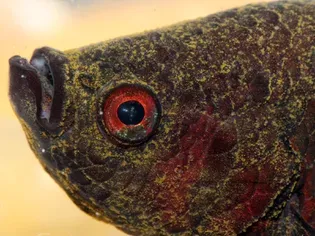Velvet: Aquarium Fish Disease Identification and Cure
Updated on 04/26/24

Velvet: Aquarium Fish Disease Identification and Cure
Introduction
Velvet, a highly contagious parasitic disease, can wreak havoc on aquarium fish populations. Caused by the protozoan parasite Amyloodinium ocellatum, velvet manifests as a fine, golden-brown dusting on the fish's body and gills. If left untreated, it can lead to severe respiratory distress and death.
Identifying Velvet Symptoms
Recognizing velvet's characteristic symptoms is crucial for timely intervention:
* Fine, golden-brown dusting: A telltale sign of velvet is a velvety coating covering the fish's skin, fins, and gills.
* Respiratory distress: Infected fish will exhibit rapid breathing, gasping at the surface, and gill flaring.
* Flashing: Fish may scrape their bodies against objects in an attempt to remove the parasites.
* Loss of appetite: Velvet can suppress fish's appetite, leading to weight loss and decreased activity.
* Death: Untreated velvet infections can result in severe organ damage and death.
Examples of Infected Fish
* Discus: Discus fish are particularly susceptible to velvet and may exhibit severe symptoms.
* Clownfish: Clownfish can also succumb to velvet, especially if their immune systems are compromised.
* Tetras: Neon tetras and other tetra species are not immune to velvet and can suffer from the infection.
Treatment Options for Velvet
* Copper-based Medications: Copper sulfate and copper chelates are effective treatments for velvet. However, it's important to follow the manufacturer's instructions carefully to avoid harming the fish.
* Malachite Green: This dye-based medication inhibits the growth of parasites. However, it can be toxic to certain fish species, so use it cautiously.
* Formalin: Formalin is a strong chemical that can kill velvet parasites. However, it must be used in low concentrations to prevent harm to the fish.
* Quarantine and Treatment: Isolate infected fish in a quarantine tank and treat them with the appropriate medication. This prevents the spread of parasites to healthy fish.
Examples of Treatment Regimes
* Copper Sulfate: Use in accordance with the manufacturer's instructions. Monitor water chemistry to prevent copper poisoning.
* Malachite Green: Add 0.05 mg/L of malachite green to the quarantine tank. Monitor fish for signs of stress and reduce dosage if necessary.
* Formalin: Add 25-50 mg/L of formalin to the quarantine tank. Leave for 24 hours, then perform a 50% water change.
Prevention and Control
* Quarantine New Fish: Quarantine new fish for several weeks before introducing them into the main tank. This helps prevent the introduction of velvet and other diseases.
* Maintain Water Quality: Good water quality helps boost fish immunity and reduce disease susceptibility. Regular water changes and filtration are essential.
* Avoid Overcrowding: Overcrowding increases stress levels in fish, weakening their immune systems. Maintain a reasonable fish population density.
Additional Tips
* Use an ultraviolet (UV) sterilizer to kill parasites in the water.
* Provide hiding places for stressed fish.
* Feed fish a healthy diet to enhance their immune systems.
* Monitor fish regularly for any signs of disease.
Conclusion
Velvet is a serious aquarium fish disease that can have devastating consequences if left untreated. By understanding its symptoms, treatment options, and preventive measures, aquarium enthusiasts can effectively combat velvet and preserve the health of their aquatic pets. Prompt diagnosis and appropriate treatment are crucial for successful management of this parasitic infection.
Explore More Pets

Freshwater Aquarium Filters
How to Deal With Cloudy Aquarium Water

Saltwater Aquarium Filters
How Do You Remove Chloramines From Tap Water?

Freshwater Aquariums & Habitat
Can I Keep My Koi Fish Inside?

Saltwater Aquariums & Habitat
14 Best Floating Plants for Your Aquarium

Freshwater Fish Health
How to Treat Ich on Freshwater Fish

Saltwater Fish Health
Fin Rot in Aquarium Fish

Freshwater Aquarium Filters
How to Do Aquarium Water Changes

Saltwater Fish Health
How Do Fish Get Parasites?